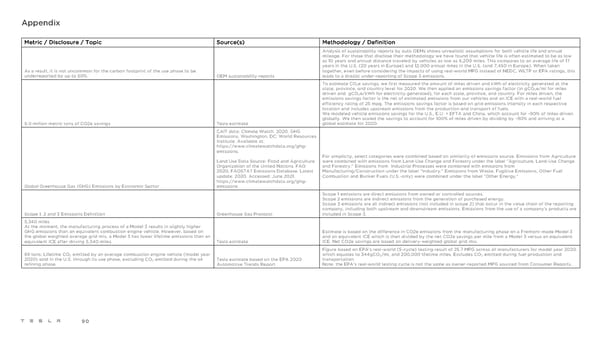Appendix Metric / Disclosure / Topic Source(s) Methodology / Definition Analysis of sustainability reports by auto OEMs shows unrealistic assumptions for both vehicle life and annual mileage. For those that disclose their methodology we have found that vehicle life is often estimated to be as low as 10 years and annual distance traveled by vehicles as low as 6,200 miles. This compares to an average life of 17 years in the U.S. (20 years in Europe) and 12,000 annual miles in the U.S. (and 7,450 in Europe). When taken As a result, it is not uncommon for the carbon footprint of the use phase to be together, even before considering the impacts of using real-world MPG instead of NEDC, WLTP or EPA ratings, this underreported by up to 50%. OEM sustainability reports leads to a drastic under-reporting of Scope 3 emissions. To estimate CO e savings, we first measured the amount of miles driven and kWh of electricity generated at the 2 state, province, and country level for 2020. We then applied an emissions savings factor (in gCO e/mi for miles 2 driven and gCO e/kWh for electricity generated), for each state, province, and country. For miles driven, the 2 emissions savings factor is the net of estimated emissions from our vehicles and an ICE with a real-world fuel efficiency rating of 25 mpg. The emissions savings factor is based on grid emissions intensity in each respective location and includes upstream emissions from the production and transport of fuels. We modeled vehicle emissions savings for the U.S., E.U. + EFTA and China, which account for ~90% of miles driven globally. We then scaled the savings to account for 100% of miles driven by dividing by ~90% and arriving at a 5.0 million metric tons of CO2e savings Tesla estimate global estimate for 2020. CAIT data: Climate Watch. 2020. GHG Emissions. Washington, DC: World Resources Institute. Available at: https://www.climatewatchdata.org/ghg- emissions. For simplicity, select categories were combined based on similarity of emissions source. Emissions from Agriculture Land Use Data Source: Food and Agriculture were combined with emissions from Land-Use Change and Forestry under the label “Agriculture, Land-Use Change Organization of the United Nations. FAO and Forestry.” Emissions from Industrial Processes were combined with emissions from 2020, FAOSTAT Emissions Database. Latest Manufacturing/Construction under the label “Industry.” Emissions from Waste, Fugitive Emissions, Other Fuel update: 2020. Accessed: June 2021. Combustion and Bunker Fuels (U.S.-only) were combined under the label “Other Energy.” https://www.climatewatchdata.org/ghg- Global Greenhouse Gas (GHG) Emissions by Economic Sector emissions Scope 1 emissions are direct emissions from owned or controlled sources. Scope 2 emissions are indirect emissions from the generation of purchased energy. Scope 3 emissions are all indirect emissions (not included in scope 2) that occur in the value chain of the reporting company, including both upstream and downstream emissions. Emissions from the use of a company’s products are Scope 1, 2 and 3 Emissions Definition Greenhouse Gas Protocol included in Scope 3. 5,340 miles At the moment, the manufacturing process of a Model 3 results in slightly higher GHG emissions than an equivalent combustion engine vehicle. However, based on Estimate is based on the difference in CO2e emissions from the manufacturing phase on a Fremont-made Model 3 the global weighted average grid mix, a Model 3 has lower lifetime emissions than an and an equivalent ICE which is then divided by the net CO2e savings per mile from a Model 3 versus an equivalent equivalent ICE after driving 5,340 miles. Tesla estimate ICE. Net CO2e savings are based on delivery-weighted global grid mix. Figure based on EPA's real-world (5-cycle) testing result of 25.7 MPG across all manufacturers for model year 2020, 69 tons: Lifetime CO emitted by an average combustion engine vehicle (model year which equates to 344gCO /mi, and 200,000 lifetime miles. Excludes CO emitted during fuel production and 2 2 2 2020) sold in the U.S. through its use phase, excluding CO emitted during the oil Tesla estimate based on the EPA 2020 transportation. 2 Note: the EPA's real-world testing cycle is not the same as owner-reported MPG sourced from Consumer Reports. refining phase. Automotive Trends Report 90
 Tesla Impact Report 2020 Page 89 Page 91
Tesla Impact Report 2020 Page 89 Page 91